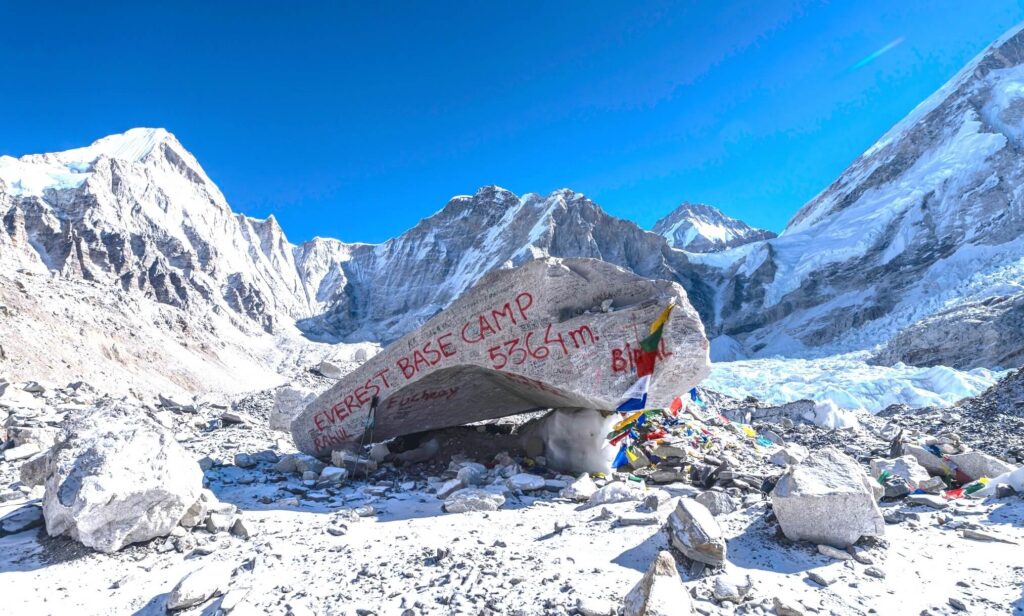
The trek from Kathmandu to Everest Base Camp is more than just a hike — it’s a soul-stretching, body-challenging, mind-expanding experience. Kathmandu, the vibrant capital of Nepal, is the center of the universe for trekkers and explorers from all around the globe, as it is the gateway for you to take on the journey that leads to the world’s tallest mountain. Yet it is not just about the foot in front of the other; it is the culture; the personal physical challenge; it is finding the spiritual connection with the soul of the people who call the Himalayan ranges home.
Everest Base Camp Trek Nepal The adventure starts in Kathmandu, a city that exudes history and is surrounded by mountains that seem to urge you on. Kathmandu’s narrow streets, bustling markets, and sacred temples provide up-close insight into Nepal’s rich culture even before the trek begins. Once supplies are gathered and trekkers meet each other, maybe stop and see some of the city’s historic spots, the journey officially begins with a flight to Lukla. The small, spectacular Lukla airport, set on the edge of a cliff, marks the point at which urban life evaporates and raw, untrammeled Himalayas take over. The flight itself is an adventure, flying low above the mountains with the plane dipping and turning to touch down on the short runway.
The trek starts from Lukla and the awe only increases as the landscape unfolds. The first days are spent hiking along verdant forests of rhododendrons and pine, crossing suspension bridges over roaring rivers, and passing through charming Sherpa villages. The trek passes every settlement that was inhabited at the time, so you get an insight into the lives of the Sherpas who had lived in these mountains for hundreds of years} You take solace in the sound of prayer flags fluttering in the wind, the sight of monks in vivid robes, the presence of Buddhist stupas — all reminders that the mountains are not merely a physical challenge, but a journey of profound spirituality.
As you climb higher into the Himalayas, the trek progressively becomes tougher. The air thins and the body starts to feel the impact of higher altitudes. Each footfall has become much more conscious, the cadence slowed down to accommodate in situ acclimatization. As the altitude increases, you start to see small shifts in the landscape — trees ceding to scraggly brushes, the trail growing narrower, the air cooler, crisper. You meet fellow trekkers from around the world with a variety of stories of how they came to this journey but with an equally shared sense of adventure and respect for the mountains.
Getting there isn’t always easy; there are times when fatigue slips in. But there’s a quality about the atmosphere of the mountains and the majesty and timelessness of their presence that renders each challenge worthwhile. The majesty of Everest looms ever larger with every torturous uphill climb, and its reward, standing at its base, more tangible.
When you finally reach Everest Base Camp, the sense of triumph is overpowering. With the epic backdrop of Mount Everest looming in front of us, its giant icy, rock face, this was our final destination. But the real prize is not the destination but the journey, the climb, the character building, and the communion with nature. The Everest Base Camp Trek is more than just a physical challenge; it’s a pilgrimage of the spirit, one that will stay with you long after returning from the mountains, and fill you with a deep appreciation for this world and its highest peak.
Before you head off to Everest make sure to get prepared in Kathmandu.
Everest Base Camp Trek Adventure The trek starts in Kathmandu, the colorful capital of Nepal. It is a metropolis of energy, culture, and adventure, and it is here where trekkers meet to gear up for what lies ahead. Most trekkers make their way to Thamel, the main tourist district, which teems with gear shops, trekking agencies, and cafés catering to adventurers. For many, the initial act is to check gear and grab any last-minute supplies. Katmandu has an impressive range of outdoor gear available, and quality gear is easy to find, from boots and jackets to trekking poles and sleeping bags.
Besides gear, trekkers should also ensure that their permits are in order. For the trek, The Sagarmatha National Park permit and the TIMS (Trekkers’ Information Management System) card are compulsory. Most trekking agencies in Kathmandu will offer packages that take care of both, as well as guides and porters, so you don’t have to worry about a thing.
Beyond the practical preparation, Kathmandu is a chance to take in some Nepali culture before tackling the mountains. Exploring temples, trying local foods, or mingling with fellow trekkers help build the fund. Then, before continuing the physical journey, there are colorful markets and ancient places in the city to explore including Durbar Square and Swayambhunath Stupa which gives tourists an idea about Nepal’s heritage and spiritual past.
To Lukla: A Buzzing Beginning
Flying from Kathmandu to Lukla is a thrilling adventure and the official beginning of the Everest Base Camp Trek. The 35-minute journey transports you from the frenetic pace of Kathmandu to the tranquil, stark landscape of the Khumbu region. Airborne, trekkers are treated to phenomenal views of the snow-capped peaks of the Himalayas. The small twin-engine plane winds its way through mountain ravines, providing an initial view of the Everest range from above. The flight is its own thrill — and is often called one of the most exciting and nerve-wracking flights in the world.
Lukla’s Tenzing-Hillary Airport, which is often referred to as the “world’s most dangerous airport,” has a short runway that slopes downward and is encircled by towering mountains, so the landing is often a dramatic event. When the plane lands on the shared dirt runway, the trek’s reality hits. Trekkers disembark at the small mountain town of Lukla, where the adventure really starts. Lukla is the gateway to the Everest region, with its humble guesthouses, small shops, and busy streets that serve trekkers and trekkers alone. With this exhilarating beginning, trekkers set out on foot; departing the comforts of Kathmandu and into the heart of the Himalayas.
Day 1 – The Everest Trek Starts: Lukla To Phakding
The first day’s hike is short (from Lukla to Phakding) but serves as a warm-up for what’s to come. Over the course of that experience, pro-research continues to develop and advance, and arriving in Lukla, trekkers set off with anticipation and fervor. The trail first walks alongside the Dudh Kosi River, a silvery river that winds through the Khumbu Valley. The trek is moderate and gives trekkers their initial introduction to Himalayan terrain. The route consists of relatively level and gentle climbs, offering you time to settle into the routine of trekking within the mountains.
Everest Base Camp Trek Difficulty Trekkers cross several suspension bridges on the way — one of the trek’s signature features — that offer stunning views of the valley around them. Along the way, trekkers will walk through small Sherpa villages and may meet friendly locals who are also just going about their daily lives. The village for the day is Phakding, a small, serene village in the valley. It provides an ideal place to stop, rest, and adjust to the elevation. Teahouses are simple yet comfortable shelters in the mountains where trekkers stay after a long day of walking, where they relish filling meals of dal bhat (lentil soup) or momo (dumplings) and trade stories with other adventurers. This first day gets us into the rhythm of what the next days will bring: more stunning scenery and more challenges.
Day 2 – Into the Heart of the Khumbu: Phakding to Namche Bazaar
On the second day of the trek, you’ll head towards the beating heart of the Khumbu, where Phakding gives way to Namche Bazaar, a Sherpa town situated at 3,440 meters (11,286 feet). This far more challenging day than the first includes a steady uphill ascent over several hours. The trail passes through lush forests of pine and rhododendron and then follows the tumbling Dudh Kosi River. As the climb becomes tougher and the steepness increases (it is 3300m), so does the altitude, making the journey where my ATL pattern was in full operation.
You are likely to meet fellow travelers as you hike, some carrying goods or trekking supplies, others tending to their daily chores. In the Khumbu it’s not just the landscape that makes your trek unique; the local life blows your mind. After several hours of relentless climbing, Namche Bazaar appears on the hillside, offering panoramic views of surrounding peaks, including the majestic mountains of Everest, Lhotse, and Ama Dablam.
Namche is a trading hub for the area, and so there are markets, restaurants, shops, and a few hotels. It is an ideal place to spend the night and start getting acclimatized to the altitude. These local Sherpa are some of the most friendly and hospitable in the world, and at the end of a long day hiking, trekkers can unwind in warm teahouses, eat a hot meal, and get ready for the next days ahead.
The First Signs of Everest: Namche and Acclimatization
Namche Bazaar is not just any stopover on the Everest Base Camp trek – it is the first location where trekkers must acclimatize to the high altitude. At 3,440 meters, Namche is high enough that altitude sickness can set in if trekkers don’t take proper precautions. So, a rest day is typically incorporated into the itinerary to accommodate the trekkers to the thinner air and avert any complications while on the trek.
The importance of acclimatization at this point cannot be overstated, as it permits the body to progressively adapt to the subtler levels of oxygen at higher altitudes. Namche provides a picturesque setting for this rest day, with breathtaking views of Everest and the surrounding peaks. Trekkers can take short hikes or excursions around the area, such as a trip to the Everest View Hotel, just a few minutes walk from Namche and one of the best spots to view Everest or visit local markets where goods from Tibet are sold.
On this rest acclimatization day, trekkers can sleep in, drink water, and get used to the strenuous trail ahead. Calm and reflection is present in the atmosphere and the beauty of the mountains. As hikers linger in Namche, the first real indications of Everest appear on the skyline, and excitement mounts. The trek has only just begun, but seeing the world’s tallest peak prepares them for the adventure ahead and fills trekkers with a renewed sense of strength and purpose.
Day 3 – The Hike to Tengboche: Where Nature Meets Spirituality
Everest Base Camp Trek Travel Guide Day 3: Namche Bazaar — → Tengboche: One of the most beautiful and spiritually enriching treks. As hikers move beyond the busy town, they enter a landscape with sweeping views of snow-capped summits including the more distant Mount Everest. The trail descends from Namche, before gently climbing toward Tengboche, snaking through fertile forests and remote villages. With the river Dudh Kosi flowing far down below, the scenery is astounding, with Everest, Lhotse, and Ama Dablam in better sight.
Tengboche is known for the Tengboche Monastery, a significant Buddhist monastery in the area. Upon arrival at the monastery, trekkers often stop to contemplate and absorb the spiritual ambiance that surrounds the region. The sounds of monks chanting and the flutter of prayer flags provide an air of pacification that fills this remote area of the Himalayas. Several trekkers stop to roam the monastery to learn about Sherpa and Buddhist traditions. The trek to Tengboche is more than just a walk; it is a spiritual journey through the dramatic landscape; the sheer scale of nature combined with the nature of the land, a moment both unto itself, connecting with the mountains and their culture.
Day 4 – The Rhythms of the Himalayas: Tengboche to Dingboche
Trekking from Tengboche to Dingboche (Day 4) — on this day you go deeper into the Khumbu Valley, further into the Himalayas. The trail is rough, the up and down steep, yet the landscape offers great sights that justify every step. The route threads through alpine meadows, tiny Sherpa settlements, and rugged ridges, with the soaring peaks of the Everest massif looming nearby. At higher altitudes, the air thins and trekkers are starting to feel the worsening effects of altitude.
Everest Base Camp Trek Training Dingboche (4,410 meters, or 14,470 feet) is a small village that provides trekkers a place to take a breather and acclimate to the altitude. Surrounding Dingboche, the landscape is breathtaking. Fields are divided by stone walls but breathtaking views of Lhotse, Makalu, and other mountains fill the view. Trekkers often do shorter acclimatization hikes on this day, like an excursion to the Nagarjun Hill nearby, to prepare for the increased altitude. The step-counter rhythm of the trek and the beauty of nature enable the trekkers to experience both the hard physicality of the dilapidated trek and the holiness of the environment. Dingboche is a very quiet stop that has a perfect combination of beauty and culture.
Day 5 – Going Up Higher and Higher: From Dingboche to Lobuche
Lobuche is where we find ourselves today, day 5 of this crazy trek, the challenging yet important leg from Dingboche to Lobuche. The day begins with rocky ground but a gradual incline, as travelers make their way toward the famous ridge that leads up to Lobuche, which sits at 4,940 meters (16,207 feet). The route provides views of peaks around, most noticeably Mount Everest and associated peaks. You feel the altitude and have to move slowly and deliberately to avoid altitude sickness and get properly acclimatized.
The trek takes you past memorials of climbers who died in pursuit of Everest’s summit, which gives the trek a somber, reflective quality. The weather can get much colder and harsher as you start to climb, so make sure to stay warm and hydrated. Trekking to Lobuche, a small, remote settlement, hikers retire to basic teahouses to rest and prepare for the final leg to Everest Base Camp. By now, the journey to Base Camp is in sight, and there is nothing but excitement and anticipation to feed on. Our hike for the day is a repeat of the test of endurance, but the payoff is the vistas and a feeling of advancement toward your eventual destination.
Day 6: The Final Push from Lobuche to EBC
Everest Base Camp Trek Day 6 is the long-anticipated last push to Everest Base Camp, the final destination that so many trekkers dream of. The trek from Lobuche to Base Camp is tiring as trekkers continue to acclimatize as they climb higher and higher in the Himalayas. The trail winds along rocky sections and leads potatoes, glaciers, and moraines, as you approach the foot of the mighty Everest. With the terrain growing more sparse, the sense of seclusion deepens and all the while, the imposing figure of Mount Everest looms above.
After a few hours of trekking, you finally catch a glimpse of your goal: the mythical Everest Base Camp. Making it to the camp itself is an act of sheer triumph. Standing at the foot of the world’s highest peak, trekkers are overwhelmed. You are surrounded by towering glaciers, icy slopes, and the peaks of Everest, Lhotse, and Nuptse, which act like sentinels around you. For many, being at Base Camp is a humbling experience: a reminder of the effort required to get to such a remote and astonishing place. It is an achievement that is not a mere geographical one, but rather is the culmination of conquering all the obstacles that all roads presented.
Triumph, Awe, and Reflection: Getting to Everest Base Camp
The trek concludes at the emotional and awe-inspiring Everest Base Camp. It’s a sense of victory that comes only after days of hard trekking, at times an increasingly challenging step at a time. Trekkers stand at the foot of Mount Everest, beneath waterfalls of glacial blue and the grandeur of the south-central Himalayas, the enormity, the might of the landscape, an imprint, an impression in the soul.
There’s a sense of awe and humility, even pride, as trekkers reflect on the journey that got them here. At this moment, all the pain of altitude, the long days and hours of walking, and the physical and mental fatigue are erased. It hits you at Base Camp that you’re standing in the footprints of a long line of adventure-seekers, explorers, and climbers who have made the journey before. This is not only about where you are going but also about where you are on the journey and what you can learn in addition to the beauty of the mountains, you learn to live as calmly and quietly as possible. For thousands of trekkers, including climbers and opt-away, Everest Base Camp is an icon of human endurance and the indomitable spirit of dreams.
End Of The Journey And (Big) Lessons Learned
EBC Trek The Everest Base Camp trek is more than just a classic walk through the Himalayas; it is a walk to explore oneself, nature, and culture. The experience stretches well beyond physical accomplishment — from the crowded bustle of Kathmandu to the remote isolation of Base Camp.
Trekkers carry away more than photographs and souvenirs; they return from the mountains with lessons in resilience, camaraderie, and the beauty of the stretch. It imparts humility, appreciation of nature, and inner strength to overcome challenges. Whether it’s the sheer thrill of having made it to Base Camp, bonding with fellow trekkers, or connecting to the heart you once lost on the land, the trek becomes one of the defining points in your life. The mountains are always in your heart as you exit the Everest region, a realization that the journey itself is as important as the destination.






